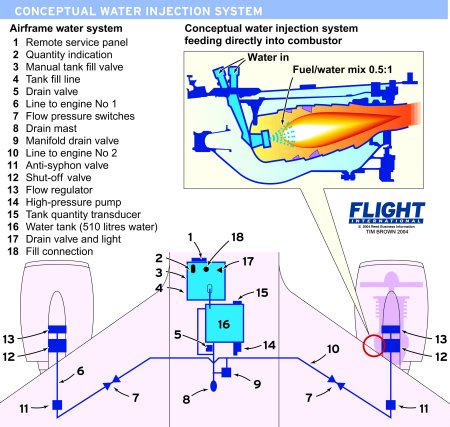Boeing-led team revives concept that could extend engine life, reduce nitrous oxide emissions and cut costs
Boeing, NASA and Pratt & Whitney have begun a feasibility study into fitting a water injection system into new and existing Boeing 747-400s that could potentially reduce emissions and at the same time cut operating costs.
The Boeing-led study, which follows pioneering work recently completed with NASA and Rolls-Royce, revives the concept of injecting water into the combustor or compressor of the jet engine for take-off.
Unlike the earliest use of this principle, which was developed to boost the take-off power of first- generation turbojets, the proposed water injection system will be used to dramatically extend the life of engines as well as to reduce emissions of nitrous oxides (NOx) in the immediate area around the airport.
In the original study with R-R, results indicated that aircraft- related operating cost savings of between 1% and 2% can be expected for a large twin such as a 777. Findings showed that "any aircraft costs and inconveniences associated with water injection are anticipated to be more than offset by engine maintenance savings", and indicated that injection into the combustor might reduce NOx emissions by as much as 90%.
The study acknowledged that water injection, responsible for spectacularly smoky departures on early jets, may "generate more hydrocarbon and carbon dioxide emissions", but said evidence from current, ground-based water injected engines "suggests this may be a manageable issue for engines with higher overall pressure ratios".
The study looked at injecting water in two ways: a "misted" conditioned water into the low-pressure compressor ahead of the turbine inlet, or a direct injection into the combustor.
The first method reduced NOx levels by around 50%, but produced larger turbine inlet temperature reductions. "But when we looked at the potential risks it took more research and development, and with the combustor method we have the experience of the aero-derivative industrial engines, which have used it for 30 years," says Boeing product development energy and emissions technology leader Dave Daggett.
The study assumes the system does not change the overall performance of the aircraft, and is therefore a crew-selectable option for use only during take-off and part of the climb-out. The combustor water injection study suggests that up to 510 litres (135USgal) is required to achieve roughly a 50% NOx reduction during a climb to 3,000ft (900m).
The study also pointed to a marked life extension for turbine blades with the decrease in inlet temperature. Using a typical General Electric CF6 as a basis, the study said 36% of the turbine blade life is consumed during take-offs, and that a combustor injection system could possibly increase life by at least 50%.
The new study, expected to be completed in February 2005, will focus on the feasibility of the system for new-build and retrofit PW4062-powered 747-400s using previously unused potential water storage areas in the aircraft, including the wing roots.
GUY NORRIS / LOS ANGELES

Source: Flight International
















